A study has found farmers can save thousands of dollars using sectional control, however there’s more to it than just that.
A few years ago, Nevin Rosaasen, policy and program specialist with the Alberta Pulse Growers (APG), was looking into cost effective technologies for farmers. Sectional control rose to the top of his list as he quickly discovered there hadn’t been any specific studies looking into the cost savings, both monetary and environmental, of the technology.
“When you set off certain sections when you’re overlapping, you just avoid double seeding, double fertilization and because of that, it can greatly reduce the cost of your inputs,” Rosaasen explains in a phone interview.
With fields including barriers in the form of bushes and wetlands, this technology helps farmers maneuver around them and not over apply on areas already seeded. It also helps discourage farmers from clearing these barriers in their fields, which in some cases are important environmental habitats.
“We’ve seen certain sustainability schemes for sourcing food in food supply chains that now will not allow farmers who either drained wetlands or removed trees, to sell into some of those markets,” Rosaasen says.
Rosaasen’s study was approved and received funding through the Canadian Agricultural Partnership (CAP) with the federal government. He also managed to get the attention of colleagues at the Alberta Wheat and Barley commissions, Alberta Canola Producers Commission, the Canola Council of Canada and Olds College, who volunteered time to help with the study. Alberta Agriculture and Forestry was also involved, however staff reductions since then has reduced the provincial role.
After receiving funding, Rosaasen launched into the first year of the study — a literary review of the technology available. The Prairie Agricultural Machinery Institute (PAMI) came on board to help with it. The second phase saw PAMI testing the technologies in fields surrounding their office at Humboldt, Sask. over the summer of 2020. The third and final phase to be completed this year will be a report where they will look at how to actually output the software with the prescribed fertilizer rate and prove it works.
Phase two was basically the ground truthing period, Rosaasen explains. “We know in theory that by shutting off sections we can reduce overlap. What we did find was that the actual overlap estimated in theory to be more than actually what is witnessed in the field.”
It was also found that the larger the obstacles and the larger the equipment used, the larger the overlap. A surprising finding was how seed size affects overlap. When comparing field peas to canola it was found peas had less overlap due to the weight and mass of their seed as they’re able to clear the tubes easier than canola seed is.
“(Peas) land in the ground sooner than canola. That might be because canola is lighter and they’re using lower wind speeds to not shatter any of the seed coats. So, some of the canola stays in the system a bit longer,” Rosaasen says.
Timing also played into overlap significantly. If the equipment operator does not have the correct timings set to shut each section off, then overlap or even misses, happen. Technology that lifts openers instead of shutting off sections was found to have benefits too, as it does not disturb the seed bed.
“That eliminates disturbance to the seed bed to the previous pass, and where that seed is placed, to ensure that you have effective seed placement and fertilizer placement as well if it’s an inch below or to the side of or just off to the edge of the seed row,” Rosaasen explains.
It was found if you’re coming into the headland at angle in your field and you are lifting sections, there can be drift on your seeding bar or tool, which causes wear on your implement. It’s also important to note the study found the direction you seed your field can have a significant affect. If you’re travelling perpendicular to your headlands and are shutting off your entire machine at the same time, you will reduce overlap, Rosaasen explains.
PAMI tested sectional control technology from various manufacturers. To measure draft in the field, they used a load cart, Katelyn Gaetz, PAMI agronomist and project lead, explains in a phone interview. This helped them compare the draft measurements to fuel usage across the field in terms of lifting and lowering sections on a drill. They also used Solidworks, a 3D computer-aided design system, to look at theoretical overlap calculations.
“Setting of your equipment is crucial in any practice that you do, and utilizing these technologies, such as sectional control, you can greatly reduce overlap on the farm, which can relate to huge cost savings as well as environmental savings,” Gaetz says. “Depending on your scenario it will change, but you can save hundreds of thousands of dollars simply by implementing technology that would reduce overlap.”
The group has been receiving interest from the industry about the study. Fertilizer Canada, Nutrien and John Deere have all reached out. Rosaasen says they’re in discussions with Nutrien to help on the third phase.





